

News
Porsche Taycan rips through Nurburgring as track-testing continues
Back in February, Porsche’s Vice President of Product Line BEV Stefan Weckbach stated that the Taycan, then widely known as the Mission E sedan, would be a track-capable vehicle. The Porsche Taycan lead threw some shade at electric car maker Tesla as well, stating that cars like the Model S P100D are limited in the way that their performance gets throttled after a few hard launches. Weckbach noted that this problem would not be present in the Taycan, Porsche’s first all-electric car.
“(Tesla’s) system is throttled. Porsche drivers won’t need to worry about that because the Mission E’s being developed to deliver reproducible performance and a top speed which can be maintained for long periods,” the Porsche exec said.
The Porsche Taycan has been seen track testing in the Nurburgring multiple times since then. Several camouflaged Taycan prototypes are doing real-world tests in multiple regions across the globe, including the Western region of South Africa, where 21 camouflaged Taycan prototypes are being tested. While these are ongoing, other camouflaged Taycan prototypes have also been spotted testing around Germany’s streets. The most recent sighting, recorded by electric car enthusiast @ZoePionierin while the vehicle was charging at a CCS station in Germany, provided a close look into the camouflaged electric car, including its strange, faux exhaust pipes and even a little bit of its frunk.
The recent sightings of the camouflaged Taycan prototypes in the Nurburgring show that Porsche is pushing hard to refine the track capabilities of its first all-electric car. Porsche’s vehicles, after all, are known for being proficient on racecourses. This past June alone, the Porsche 919 Evo set the record for the fastest lap around the Nurburgring, completing the course in 5:19.55. The 919 is a hybrid vehicle, and its permanently excited synchronous motors (PSM) — which Porsche calls the “turbos of the electric milieu” — will be used as basis for the Taycan’s electric motors.
The frequent tests of the Taycan in the Nurburgring show how a legacy automaker approaches the development of a vehicle’s track capabilities. Being a veteran in the auto industry, Porsche appears to be refining the Taycan’s track features through consistent testing around racecourses like the Nurburgring. This strategy is quite different from Tesla, whose development of the Model 3 Performance’s Track Mode was largely unknown until the feature was mentioned by YouTube host Marques Brownlee in a test drive of the vehicle. Nevertheless, the Model 3 Performance’s Track Mode, as shown in tests by Road and Track, proved that the feature does make the electric sedan capable of being driven hard for extended periods of time.
The Porsche Taycan is set to be equipped with two permanently excited synchronous motors (PSM) that produce a combined 600 hp (440 kW). The company lists the vehicle with a 0-60 mph time of 3.5 seconds, a top speed of 155 mph, and a range of ~310 miles per charge. Porsche expects to build the Taycan in its Zuffenhausen plant in Stuttgart, Germany — the same site where it manufactures the Porsche 911, 718 Boxster, and the 718 Cayman.
Watch the Porsche Taycan take on the Nurburgring in the videos below.

Elon Musk
Elon Musk and Tesla AI Director share insights after empty driver seat Robotaxi rides
The executives’ unoccupied tests hint at the rapid progress of Tesla’s unsupervised Robotaxi efforts.

Tesla CEO Elon Musk and AI Director Ashok Elluswamy celebrated Christmas Eve by sharing personal experiences with Robotaxi vehicles that had no safety monitor or occupant in the driver’s seat. Musk described the system’s “perfect driving” around Austin, while Elluswamy posted video from the back seat, calling it “an amazing experience.”
The executives’ unoccupied tests hint at the rapid progress of Tesla’s unsupervised Robotaxi efforts.
Elon and Ashok’s firsthand Robotaxi insights
Prior to Musk and the Tesla AI Director’s posts, sightings of unmanned Teslas navigating public roads were widely shared on social media. One such vehicle was spotted in Austin, Texas, which Elon Musk acknowleged by stating that “Testing is underway with no occupants in the car.”
Based on his Christmas Eve post, Musk seemed to have tested an unmanned Tesla himself. “A Tesla with no safety monitor in the car and me sitting in the passenger seat took me all around Austin on Sunday with perfect driving,” Musk wrote in his post.
Elluswamy responded with a 2-minute video showing himself in the rear of an unmanned Tesla. The video featured the vehicle’s empty front seats, as well as its smooth handling through real-world traffic. He captioned his video with the words, “It’s an amazing experience!”
Towards Unsupervised operations
During an xAI Hackathon earlier this month, Elon Musk mentioned that Tesla owed be removing Safety Monitors from its Robotaxis in Austin in just three weeks. “Unsupervised is pretty much solved at this point. So there will be Tesla Robotaxis operating in Austin with no one in them. Not even anyone in the passenger seat in about three weeks,” he said. Musk echoed similar estimates at the 2025 Annual Shareholder Meeting and the Q3 2025 earnings call.
Considering the insights that were posted Musk and Elluswamy, it does appear that Tesla is working hard towards operating its Robotaxis with no safety monitors. This is quite impressive considering that the service was launched just earlier this year.
Elon Musk
Starlink passes 9 million active customers just weeks after hitting 8 million
The milestone highlights the accelerating growth of Starlink, which has now been adding over 20,000 new users per day.

SpaceX’s Starlink satellite internet service has continued its rapid global expansion, surpassing 9 million active customers just weeks after crossing the 8 million mark.
The milestone highlights the accelerating growth of Starlink, which has now been adding over 20,000 new users per day.
9 million customers
In a post on X, SpaceX stated that Starlink now serves over 9 million active users across 155 countries, territories, and markets. The company reached 8 million customers in early November, meaning it added roughly 1 million subscribers in under seven weeks, or about 21,275 new users on average per day.
“Starlink is connecting more than 9M active customers with high-speed internet across 155 countries, territories, and many other markets,” Starlink wrote in a post on its official X account. SpaceX President Gwynne Shotwell also celebrated the milestone on X. “A huge thank you to all of our customers and congrats to the Starlink team for such an incredible product,” she wrote.
That growth rate reflects both rising demand for broadband in underserved regions and Starlink’s expanding satellite constellation, which now includes more than 9,000 low-Earth-orbit satellites designed to deliver high-speed, low-latency internet worldwide.
Starlink’s momentum
Starlink’s momentum has been building up. SpaceX reported 4.6 million Starlink customers in December 2024, followed by 7 million by August 2025, and 8 million customers in November. Independent data also suggests Starlink usage is rising sharply, with Cloudflare reporting that global web traffic from Starlink users more than doubled in 2025, as noted in an Insider report.
Starlink’s momentum is increasingly tied to SpaceX’s broader financial outlook. Elon Musk has said the satellite network is “by far” the company’s largest revenue driver, and reports suggest SpaceX may be positioning itself for an initial public offering as soon as next year, with valuations estimated as high as $1.5 trillion. Musk has also suggested in the past that Starlink could have its own IPO in the future.
News
NVIDIA Director of Robotics: Tesla FSD v14 is the first AI to pass the “Physical Turing Test”
After testing FSD v14, Fan stated that his experience with FSD felt magical at first, but it soon started to feel like a routine.

NVIDIA Director of Robotics Jim Fan has praised Tesla’s Full Self-Driving (Supervised) v14 as the first AI to pass what he described as a “Physical Turing Test.”
After testing FSD v14, Fan stated that his experience with FSD felt magical at first, but it soon started to feel like a routine. And just like smartphones today, removing it now would “actively hurt.”
Jim Fan’s hands-on FSD v14 impressions
Fan, a leading researcher in embodied AI who is currently solving Physical AI at NVIDIA and spearheading the company’s Project GR00T initiative, noted that he actually was late to the Tesla game. He was, however, one of the first to try out FSD v14.
“I was very late to own a Tesla but among the earliest to try out FSD v14. It’s perhaps the first time I experience an AI that passes the Physical Turing Test: after a long day at work, you press a button, lay back, and couldn’t tell if a neural net or a human drove you home,” Fan wrote in a post on X.
Fan added: “Despite knowing exactly how robot learning works, I still find it magical watching the steering wheel turn by itself. First it feels surreal, next it becomes routine. Then, like the smartphone, taking it away actively hurts. This is how humanity gets rewired and glued to god-like technologies.”
The Physical Turing Test
The original Turing Test was conceived by Alan Turing in 1950, and it was aimed at determining if a machine could exhibit behavior that is equivalent to or indistinguishable from a human. By focusing on text-based conversations, the original Turing Test set a high bar for natural language processing and machine learning.
This test has been passed by today’s large language models. However, the capability to converse in a humanlike manner is a completely different challenge from performing real-world problem-solving or physical interactions. Thus, Fan introduced the Physical Turing Test, which challenges AI systems to demonstrate intelligence through physical actions.
Based on Fan’s comments, Tesla has demonstrated these intelligent physical actions with FSD v14. Elon Musk agreed with the NVIDIA executive, stating in a post on X that with FSD v14, “you can sense the sentience maturing.” Musk also praised Tesla AI, calling it the best “real-world AI” today.








